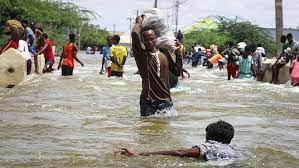Somali Magazine – The UN has released US$25 million to Somalia’s flooding victims to help them jump-start their lives.
According to UN Office for the Coordination of Humanitarian Affairs (OCHA} nearly 1.2 million people in Somalia are already affected by heavy rains and flooding and more are expected.
The United Nations and its partners estimate that 1.6 million people could be affected by flooding in the current deyr (October to December) rainy season, with 1.5 million hectares of farmland potentially being destroyed. Increased rainfall is forecast due to a concurrence of El Niño conditions and a positive Indian Ocean Dipole phenomenon.
The Food and Agriculture Organization’s Somali Water and Land Information Management projects a flood event of a magnitude statistically likely only once in 100 years, with significant anticipated humanitarian impacts.
While all possible preparatory measures are being pursued, a flood of this magnitude can only be mitigated and not prevented. Early warning and early action can save lives and livelihoods, but large-scale displacement, increased humanitarian needs and further destruction of property remain likely.
The newly released funds – $10 million from the Central Emergency Fund (CERF) and $15 million from the Somalia Humanitarian Fund – will support efforts to prevent loss of life, stem disease outbreaks, and address food insecurity. Somalia, which has been emerging from a historic drought, is one of many countries facing a heightened risk of flooding, drought, and extreme heat in the coming months spurred by the El Niño and the positive Indian Ocean Dipole.
“Extreme weather linked to the ongoing El Niño risks further driving up humanitarian needs in already-vulnerable communities in Somalia and many other places,” said Martin Griffiths, Under-Secretary-General for Humanitarian Affairs and Emergency Relief Coordinator. “We know what the risks are, and we need to get ahead of these looming crises.”
The CERF funds will help UN agencies and partners assist more than 280,000 people during the initial phase of the crisis, while the Somalia Humanitarian Fund resources will support more than 420,000 people. The humanitarian system now regularly incorporates extreme weather warnings, including seasonal forecasting, to inform anticipatory and early action to get ahead of crises. CERF is using a proactive approach to address the potential consequences of the current El Niño globally.

